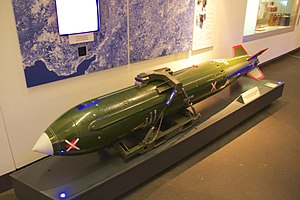WE177
| WE.177 | |
|---|---|

WE.177 nuclear bomb at the
Imperial War Museum North. |
|
| Type | Free-fall gravity nuclear bomb |
| Place of origin | United Kingdom |
| Service history | |
| In service | September 1966–1998 |
| Used by |
British Armed Forces: *Royal Navy, *Royal Air Force |
| Wars | Cold War |
| Production history | |
| Designer | Atomic Weapons Research Establishment (AWRE), Aldermaston |
| Manufacturer | Atomic Weapons Research Establishment (AWRE), Aldermaston |
| Unit cost | unknown |
| No. built | ~319 |
| Variants | WE.177A, WE.177B, WE.177C |
| Specifications | |
| Weight |
WE.177A: 272 kilograms (599.7 lb), WE.177B: 457 kilograms (1,007.5 lb), WE.177C: 457 kilograms (1,007.5 lb) |
| Length |
WE.177A: 112 inches (284.5 cm), WE.177B: 133 inches (337.8 cm), WE.177C: 133 inches (337.8 cm) |
| Diameter | all: 16 inches (40.6 cm), |
|
|
|
| Filling |
WE.177A: ZA297 primary fission warhead, WE.177B: ZA297 primary fission warhead & PT176 secondary thermonuclear fusion warhead, WE.177C: ZA297 primary fission warhead & PT176 secondary thermonuclear fusion warhead, |
| Filling weight | unknown |
| Blast yield |
WE.177A: 0.5 kilotons or 10 kilotons WE.177B: 450 kilotons WE.177C: 200 kilotons |
The WE.177, originally known as WE 177, and sometimes incorrectly known as WE177, was the military designation of a range of aircraft delivered tactical and strategic gravity free-fall nuclear bombs made available to and deployed by two services of the British Armed Forces; namely the Royal Navy (RN) and the Royal Air Force (RAF). WE.177 was created at the request of the British Air Ministry to meet the Operational Requirement OR.1177, and one variant entered service in 1966, initially with only the Royal Air Force.
There were three versions; WE.177A was a boosted fission weapon, while WE.177B and WE.177C were thermonuclear weapons. All could be delivered by fixed-wing aircraft, and also, in the case of the WE.177A, in anti-submarine mode, by helicopters and by the Ikara missile system. All types could be parachute retarded.
The first version to be fully deployed, the WE.177B, was delivered to the Royal Air Force (RAF) at RAF Cottesmore in September 1966, followed by deliveries of the WE.177A to the Royal Navy (RN) beginning in 1969, and the RAF in 1971, after a delay caused by the need to produce the ET.317 warhead for the UK Polaris A3T first; and was followed by WE.177C deliveries to the RAF. The Navy weapons were retired by 1992, and all other weapons with the RAF were retired by 1998. When it was finally withdrawn in 1998, the WE.177 had been in service longer than any other British nuclear weapon.
...
Wikipedia
